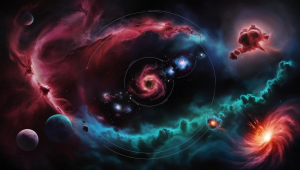
WORMHOLES:COSMIC SHORTCUTS
What if you could rocket from Earth, not to the Moon or Mars, but down a wormhole that loops all the way across the vast Milky Way, slashing travel time
The Universe, huge and also mystical, has actually gone through a remarkable trip given that its beginning almost 13.8 billion years back. From the eruptive minute of the Big Bang to the growth of galaxies, stars as well as earths the cosmos’s development is a tale of planetary development, change as well as intricacy. As researchers remain to piece this story making use of sophisticated telescopes satellites plus academic versions, our understanding of the universe’s past present as well as future expands. This write-up discovers the crucial phases in the world’s advancement starting with the Big Bang coupled with causing today.
The Big Bang: The Birth of universe
The tale of the universe starts with the Big Bang a single occasion that notes the beginning of area, time, together with issues. Prior to the Big Bang there was no area or time as we recognize it– every little thing that would certainly at some point come to be the universe was focused right into an infinitely small as well as thick factor called a singularity. Around 13.8 billion years earlier this harmony swiftly broadened, launching an enormous quantity of power along with triggering the universe.
In the very first portions of a 2nd the cosmos was very warm coupled with thick plasma of bits. As it increased it started to cool down enabling bits like quarks as well as electrons to create. Quarks are incorporated to develop protons as well as neutrons, the foundation of atomic cores. Within minutes of the Big Bang, a procedure called nucleosynthesis happened, developing the cores of the easiest components, primarily hydrogen coupled with helium, together with trace quantities of lithium.
Then the world was still nontransparent, full of a thick soup of bits as well as radiation. It had not been until 380,000 years after the Big Bang that the universe cooled down sufficiently for electrons to integrate with protons developing neutral hydrogen atoms in a procedure called settlement. This enabled light to take a trip openly for the very first time developing what we currently observe as the Cosmic Microwave Background Radiation– a pale radiance that acts as a photo of the very early world.
The Dark Ages not to mention the First Stars
After installment, the world went into a duration called the Dark Ages, lasting numerous countless years. Throughout this moment, there were no stars or galaxies, and the universe teemed with dark issues, hydrogen gas, and also radiation. Dark issues though unseen played an essential duty to fit the large framework of the universe. Its gravitational pull created gas to glob with each other in thick areas, developing the seeds for the initial stars plus galaxies.
Around 100 to 200 million years after the Big Bang the initial stars started to create in these thick areas of gas. These very early stars, called Population III stars, were large and also short-term, melting via their gas promptly as well as finishing their lives in marvelous supernova surges. These supernovae enriched the bordering gas with larger aspects which would certainly later on be crucial for the development of earths as well as life.
As even more stars were created, their radiation started to re-ionize the bordering hydrogen gas, finishing the Dark Ages and also starting the Epoch of Reionization. This duration, which lasted numerous hundred million years, saw the birth of the initial galaxies as well as galaxy clusters coupled with the world progressively ending up being a lot more clear to light.
The Formation of Galaxies along with Large-Scale Structures
Gradually the gravitational pull of dark matter as well as the blend of gas clouds resulted in the development of galaxies. Galaxy development is a power structure, with smaller sized frameworks combining to create bigger ones. These galaxies started to gather with each other because of gravitation developing large frameworks like galaxy collections as well as superclusters.
Our very own galaxy, the Milky Way began developing around 13.6 billion years earlier. It becomes part of a bigger collection of galaxies referred to as the Local Group which additionally consists of the Andromeda Galaxy together with numerous smaller sized galaxies. The Milky Way like various other galaxies is bordered by a halo of dark matter that offers much of its mass.
Galaxies are not fixed; they progress with time via mergings, crashes, plus the development of brand-new stars. These procedures remain to form the framework of galaxies and also add to the general development of the universe.
The Role of Dark Energy and also the Expanding Universe
Among one of the most shocking explorations of the 20th century was the understanding that the universe is not just broadening yet that the development is increasing. This sensation is credited to dark power, a mystical pressure that comprises 70% of the universe’s complete power material. Dark power opposes the gravitational pull of the issue, creating galaxies to vacate each other at a significantly greater rate.
The exploration of dark power has actually brought about a brand-new understanding of the universe’s future. Without it the gravitational pull of the issue would certainly have ultimately reduced the development of the universe, possibly bringing about a Big Crunch– a circumstance in which the universe would certainly break down back right into a harmony. Nonetheless, with the impact of dark power the world shows up predestined to increase permanently expanding chillier coupled with much more diffuse with time in what is called the Big Freeze.
The Present-Day Universe and also Beyond
Today, the universe is around 138 billion years old as well as remains to increase. It has numerous billions of galaxies, each house to millions or billions of stars. Our planetary system belongs to the Milky Way galaxy, created around 4.6 billion years earlier from a cloud of gas as well as dirt. The development of Earth as well as the growth of life stand for simply a little portion of the universe’s length, not to mention its intricate background.
As we look to the future, scientists continue to study the universe’s evolution using powerful telescopes like the James Webb Space Telescope and advanced simulations. These tools allow us to peer deeper into space and further back in time, offering insights into the universe’s earliest moments and its ultimate fate.
The advancement of the universe from the Big Bang to the present is a tale of change, intricacy as well as planetary development. Via procedures of cooling down, star development, galaxy development, plus the impact of dark power, the universe has actually expanded from a warm, thick plasma to the huge, organized universes we see today. While much has actually been revealed, the universe’s trip proceeds, with lots of inquiries still waiting for solutions leaving researchers as well as astronomers to discover the endless opportunities of area plus time.

What if you could rocket from Earth, not to the Moon or Mars, but down a wormhole that loops all the way across the vast Milky Way, slashing travel time

If you go outdoors on a clear evening and also search for it, you might have the ability to see Jupiter beaming brilliantly amongst the celebrities. At the exact same

Stars, the dazzling points of light that fill up the evening skies are the foundation of galaxies plus the cradles of life itself. From their birth in large clouds of

In the mission to recognize deep space mankind has actually developed progressively effective devices to observe deep space. Completion of this venture is the Extremely Large Telescope (ELT) which is

Space debris, also known as space junk, refers to the defunct artificial objects orbiting Earth. These objects include decommissioned satellites, spent rocket stages, and fragments from collisions and explosions.

The search for exoplanets– planets that orbit stars outside our planetary system– has actually quickly developed into one of the most interesting and dynamic fields of astronomy
Write to
Jasmine Gogoi at csr@scientifictemperament.com
Let’s develop our society with a scientific heart. Join us to build the scientifically nurtured future →